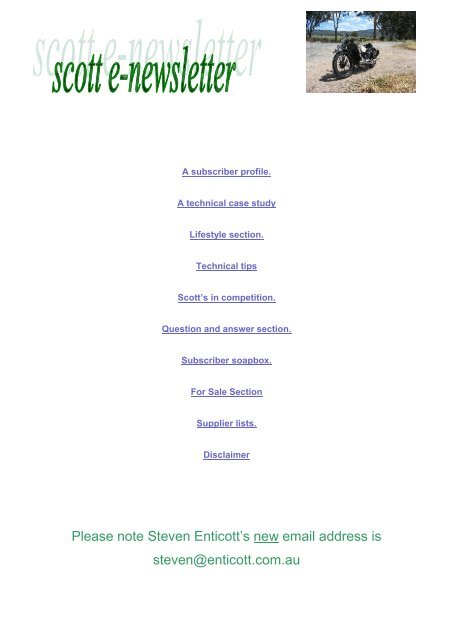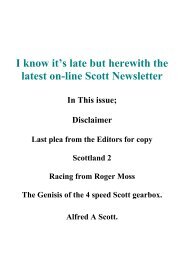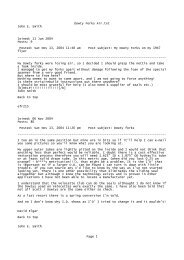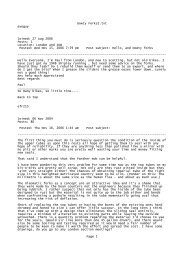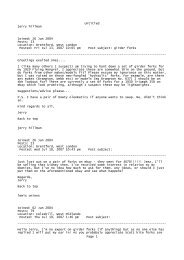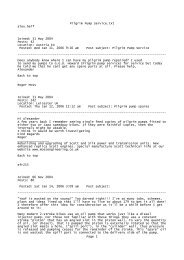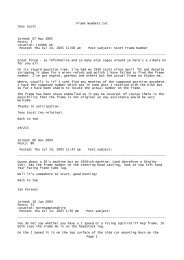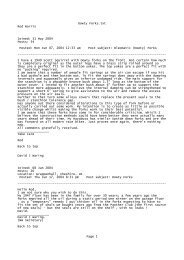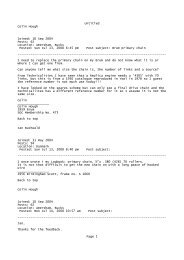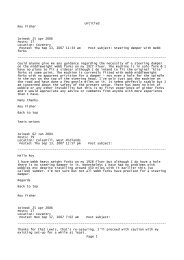to Download PDF file - Moss Engineering
to Download PDF file - Moss Engineering
to Download PDF file - Moss Engineering
You also want an ePaper? Increase the reach of your titles
YUMPU automatically turns print PDFs into web optimized ePapers that Google loves.
A subscriber pro<strong>file</strong>.<br />
A technical case study<br />
Lifestyle section.<br />
Technical tips<br />
Scott’s in competition.<br />
Question and answer section.<br />
Subscriber soapbox.<br />
For Sale Section<br />
Supplier lists.<br />
Disclaimer<br />
Please note Steven Enticott’s new email address is<br />
steven@enticott.com.au
The Scott e-newsletter<br />
Produced by Steven Enticott and Roger <strong>Moss</strong> as a private non profit making project. It is<br />
intended for all who have an interest in Scott mo<strong>to</strong>rcycles, their variants and their his<strong>to</strong>ry. The<br />
objective of this free monthly newsletter by email is <strong>to</strong> promote a sense friendship, fellowship<br />
and objective mutual help and interest, using modern communication technology.<br />
This newsletter is not connected with “The Scott Owners Club” or any of its sections. We do,<br />
however recommend membership of the SOC <strong>to</strong> those with serious long term Scott interests.<br />
Roger <strong>Moss</strong> and Steven Enticott are both members.<br />
We are very happy indeed <strong>to</strong> receive your suggestions and especially your contributions <strong>to</strong><br />
improve and develop this newsletter. In truth, if you like the concept, please help with the<br />
contributions, as the organisers will find it difficult <strong>to</strong> continue <strong>to</strong> supply regular new copy<br />
unaided. Help us <strong>to</strong> help you!<br />
Other languages.<br />
We publish this newsletter <strong>to</strong> help others. We do not reserve copyright. We would be very<br />
pleased if any person wished <strong>to</strong> translate the published information and make it freely available<br />
in any other language.<br />
For commercial re publishing in the English language.<br />
Please contact us first, but hey we need the publicity, just acknowledge your source, this is all<br />
we will ask.<br />
To receive your free newsletter, send us s<strong>to</strong>ries for publication, feedback, support or simply <strong>to</strong><br />
be taken of the list contact Steven Enticott at steven@enticott.com.au<br />
To send technical copy please contact Roger <strong>Moss</strong> at roger@mossengineering.co.uk<br />
Edition 2. - 2 – August 2005
A subscriber pro<strong>file</strong>.<br />
Before explaining how I became involved with the<br />
res<strong>to</strong>ration of a Scott it may be an advantage <strong>to</strong> consider<br />
why. The Scott was after all no more than boxes of parts,<br />
none were assembled and there was obviously much more<br />
missing than present. This basically was the attraction, as<br />
the following account will make clear - I do like a challenge!<br />
My involvement with mo<strong>to</strong>rcycles began with a bad experience at the tender age of fourteen<br />
and as that was close <strong>to</strong> fifty years ago it can be said that the initial trauma did not put me off<br />
<strong>to</strong>o much. With the lucidity of memory that comes with advancing years I can still recall all the<br />
major elements of that fateful day. A slightly older school friend Mike, arrived in our village on a<br />
mo<strong>to</strong>rcycle, it was a green, plunger framed, three speed<br />
125cc Bantam and I was fascinated. He had ridden it from his house down the back lanes that<br />
were at that time merely tracks rather than proper roads. I was absolutely fascinated by the<br />
whole thing and he delighted in showing me all the controls and gave several demonstrations of<br />
how <strong>to</strong> start and ride the beast. Adulation and begging proved their worth and Mike was at last<br />
persuaded <strong>to</strong> let me have a go but not on the road. If I followed him back <strong>to</strong> the cindertrack lane<br />
I could ride there without much chance of encountering any traffic.<br />
Once in position I was given my final instructions with especial emphasis on the necessity for<br />
completely pulling in the clutch lever when changing gear. With the engine running and first<br />
gear selected I slowly released the clutch and was off up the track. Having <strong>to</strong> change up <strong>to</strong><br />
second and then <strong>to</strong>p gear meant that I did not, at first, have the time <strong>to</strong> appreciate the ride but<br />
as I cruised along in <strong>to</strong>p I was enthralled by the power (yes I know it was only a Bantam) and<br />
control.<br />
This was far, far better than riding Dinah the retired carthorse who the village children had learnt<br />
could be tempted with a carrot or a handful of grass <strong>to</strong> come <strong>to</strong> the gate. The gate was then<br />
used as a boarding platform <strong>to</strong> jump on<strong>to</strong> her back where, depending on her mood, she would<br />
either walk off slowly <strong>to</strong> the middle of the field and stand still despite all our urging and we would<br />
be forced by boredom <strong>to</strong> slide off, or sometimes be lively enough <strong>to</strong> break in<strong>to</strong> a slow canter<br />
that still provided enough movement <strong>to</strong> dislodge her load of laughing children.<br />
Edition 2. - 3 – August 2005
On the mo<strong>to</strong>rbike I was in control of both speed and distance and despite the rutted track the<br />
speed I achieved was certainly enough <strong>to</strong> instil that little edge of fear that prevents the use of<br />
full throttle. I know I overstretched the limits set by Mike as <strong>to</strong> how far down the lane I should<br />
ride but I did eventually slow down, turn round and set off back. Beginning the return, first gear<br />
was supplanted by second and before I made the change up <strong>to</strong> <strong>to</strong>p I let the revs rise much<br />
further than the first time so that the little bike was starting <strong>to</strong> buck and weave over the ruts as I<br />
prepared <strong>to</strong> change up <strong>to</strong> <strong>to</strong>p. It was here that my concentration was rudely broken as in my<br />
effort <strong>to</strong> fully pull in the clutch lever I used the wrong hand and applied the front brake locking up<br />
the front wheel.<br />
This was the conclusion that we came <strong>to</strong> later as we held an inquest in<strong>to</strong> what had happened <strong>to</strong><br />
pitch me forward over the bars and the bike, free of its incompetent rider and hindrance of front<br />
braking remained upright for a considerable distance before wobbling slowly up <strong>to</strong> the hawthorn<br />
hedge and there, still upright, the engine stalled. Mike could not believe that I had sustained so<br />
many cuts; bruises and abrasions while his bike had not even been scratched in its encounter<br />
with the hedge. Mike will crop up later in the s<strong>to</strong>ry as our paths cross again but for the moment it<br />
is sufficient <strong>to</strong> say that because his bike was undamaged we remained friends and that I,<br />
despite the pain, was firmly addicted <strong>to</strong> mo<strong>to</strong>rcycles.<br />
I cannot remember where my first bike came from or where it went <strong>to</strong> but in the way that first<br />
time for some things tend <strong>to</strong> stick in the mind I can remember its number OFM 707. It was a<br />
Royal Enfield 125cc Ensign and it was a 'seven mile machine'. This was because of my naivety<br />
and lack of experience with things like spring washers! A previous owner had either lost or just<br />
not put back the two spring washers on the 2BA screws that secured the timing plate so that,<br />
after timing the points <strong>to</strong> the correct position, the bike would start and run for about fifteen<br />
minutes before the back plate turned until the engine slowed and s<strong>to</strong>pped. Resetting the timing<br />
would effect a cure but for weeks I was satisfied <strong>to</strong> have a bike that would at least get me out <strong>to</strong><br />
explore the immediate surrounding roads even if that did involve several s<strong>to</strong>ps.<br />
I had by now started work as an apprentice electrician with ICI and for the first six months this<br />
meant being an office boy at the local chemical works. The real training was at the Apprentice<br />
Training School and this was quite some distance away from our village and also on the far side<br />
of the river Mersey. I was very fortunate in that a lad from the village two years my senior was<br />
also attending the school and he had a 175 Bantam Super with a dual seat.<br />
Edition 2. - 4 – August 2005
With arrangements for sharing petrol cost made we had a four-month stint riding through some<br />
really bad winter weather with the added complication of the Runcorn - Widnes Transporter<br />
Bridge adding its own unique obstacle <strong>to</strong> our journey. This was at that time the only way for<br />
road traffic <strong>to</strong> cross the Mersey between Liverpool and Warring<strong>to</strong>n and it had a basic problem,<br />
apart from its age related unreliability, it could not operate in high winds. For those unfamiliar<br />
with this type of river crossing an underslung platform big enough <strong>to</strong> take about six cars and<br />
twenty or so passengers was pulled back and forth over the river and the Manchester Ship<br />
Canal. Boats passing up and down the canal had right of way so there were numerous delays<br />
incurred waiting for ships <strong>to</strong> pass as well as those previously mentioned. For car driver there<br />
was no alternative but <strong>to</strong> wait but <strong>to</strong> intrepid mo<strong>to</strong>rcyclists who could not afford <strong>to</strong> be late for<br />
work whatever the cause there was another route, the Old Railway Bridge. Constructed <strong>to</strong> carry<br />
the main Liverpool <strong>to</strong> London main line it had at the Widnes end a <strong>to</strong>ll booth and at Runcorn a<br />
much more daunting obstacle - six flights of steps for pedestrians <strong>to</strong> negotiate. It was up and<br />
down these steps that we had <strong>to</strong> push/carry/ride the Bantam on every occasion that the<br />
Transported was inoperative, which in winter seemed more often than not.<br />
The Runcorn Transporter Bridge with the Old Bridge in the background<br />
It was for me fortui<strong>to</strong>us that my rides on the Bantam were <strong>to</strong> be curtailed as the rider’s term<br />
finished and I still had another two months <strong>to</strong> go. It was the excuse needed for me <strong>to</strong> buy the<br />
first of only two new road bikes I have ever owned. Apprentice’s wages meant that it had <strong>to</strong> be<br />
purchased on the ‘drip feed’ method but it did provide an economical and very enjoyable means<br />
of transport <strong>to</strong> work as well as giving ultra reliable service for forays in<strong>to</strong> Wales and the Peak<br />
District at weekends.<br />
Edition 2. - 5 – August 2005
My choice, determined mainly by affordability plus racing success in the Isle of Man was a 50cc<br />
Suzuki AKC 9B on which I covered over thirty thousand miles with only plugs and rear chain<br />
replacement adding <strong>to</strong> the services that I carried out. It did eventually expire but only as the<br />
result of my stupidity and was again due <strong>to</strong> my inability <strong>to</strong> differentiate between left and right,<br />
only this time it was my feet that caused the trouble rather than my hands.<br />
I had set out <strong>to</strong> go fishing in Wales at spot just over fifty miles from home and it was on a<br />
no<strong>to</strong>rious set of bends that <strong>to</strong>ok the road over a railway track that I encountered, on the wrong<br />
side of the road, a car who’s driver had lost control round the first bend. Although it would have<br />
been impossible <strong>to</strong> s<strong>to</strong>p the reflex action of applying the brakes had the unfortunate<br />
consequences for the left hand side mounted gear lever that I stamped on, jamming the<br />
gearbox in second. I managed <strong>to</strong> avoid serious injury by swerving out of the path of the car but<br />
in the time it <strong>to</strong>ok me <strong>to</strong> s<strong>to</strong>p, recover and look back all I could see was the rapidly disappearing<br />
rear bumper as the car sped away.<br />
Maureen (my future wife) on the Suzuki<br />
No amount of roadside fiddling would free the gearbox and as this was well before there was<br />
any help, other than that provided by fellow riders, I set out for home with the poor little engine<br />
practically glowing red-hot as I tried <strong>to</strong> keep up a speed whereby I was not being overwhelmed<br />
by other traffic.<br />
To its everlasting credit the bike got me back <strong>to</strong> within a mile of home before crying enough and<br />
the engine s<strong>to</strong>pped with a series of ominous backfires. It later transpired that the flywheel<br />
magne<strong>to</strong> had developed a crack and unable <strong>to</strong> afford a replacement I reluctantly left the bike in<br />
the hands of the dealer having negotiated some small value by using it as part exchange for a<br />
Edition 2. - 6 – August 2005
very tired looking Ariel Arrow. His<strong>to</strong>rically the Suzuki was also significant in that in brought me<br />
in<strong>to</strong> contact with another apprentice Paul, who had a 500cc BSA A7 twin. We became firm<br />
friends and the two of us formed an unlikely pair as we rode <strong>to</strong>gether most weekends. Paul still<br />
has his BSA and although very limited by arthritis manages <strong>to</strong> ride it on a fair number of<br />
occasions.<br />
Mike now re-enters the tale. He had since leaving school put his considerable skill <strong>to</strong> use by<br />
opening, in a local air raid shelter, a mo<strong>to</strong>rcycle and scooter repair shop. This was <strong>to</strong> become a<br />
Mecca for lots of local riders and Mike’s interest in not only repairing but also tuning bikes was<br />
legendary. He had a 200cc Sports Arrow as his test bed and had at various times fitted it with<br />
oversized carburet<strong>to</strong>rs, then disc valves (home made) and even casting aluminium, - with the<br />
aid of the fan in his mum’s vacuum cleaner – <strong>to</strong> make a larger front brake drum.<br />
I swapped my Arrow for this potent little machine but not before Mike had put it back externally<br />
<strong>to</strong> standard. The padded flywheels polished ports and high compression pis<strong>to</strong>n were however<br />
still inside and as such it had quite as<strong>to</strong>nishing performance for such a small capacity engine,<br />
Again with the luck so often bes<strong>to</strong>wed on ugly people I was fortunate in that Paul had found two<br />
four stroke really scruffy Ariel’s for sale but could not afford them both. He bought the Square<br />
Four and I bought the 500cc VHA. That it was my first res<strong>to</strong>ration was also lucky in that I was<br />
determined <strong>to</strong> make the best job I could of the project. It was here that the basics of all future<br />
res<strong>to</strong>rations were learnt, never believe estimates of either time or money, do as much of the<br />
work yourself as you possibly can, always use the best replacements you can afford for missing<br />
or unserviceable parts.<br />
It also helps if you multiply the amount of time the project will take by a fac<strong>to</strong>r of at least two. In<br />
my case in was probably nearer <strong>to</strong> three and again in the continued serendipity that marks my<br />
life, in the week that I got all the paperwork necessary <strong>to</strong> put the VHA on the road as SLG 76H, I<br />
managed, through grossly over revving <strong>to</strong> try and pass another bike <strong>to</strong> blow up the Sports Arrow<br />
and put a rod through the bot<strong>to</strong>m of the crankcase. That the VHA would lead me in<strong>to</strong> so many<br />
unexpected situations was as<strong>to</strong>unding.<br />
Jeff Meehan - jeff.meehan@ntlworld<br />
This ends part 1 of Jeff’s tale – subsequent parts will follow in the coming eNewsletter months.<br />
Edition 2. - 7 – August 2005
A technical case study<br />
Case Study no. 1<br />
Background. An engineer <strong>to</strong>olmaker has a couple of Scotts during his active lifetime. His son<br />
grows up with the evocative memories of radia<strong>to</strong>rs and stirring exhaust notes. Father retires<br />
and son wishes <strong>to</strong> find a Scott for them <strong>to</strong> res<strong>to</strong>re <strong>to</strong>gether. Before a suitable machine can be<br />
found, the father dies. After some time the son decides <strong>to</strong> continue the search for a Scott that<br />
he can res<strong>to</strong>re in his father's memory. A bike is found and after a brief trial, is purchased.<br />
The purchase is derided by working colleagues who ride only modern bikes.<br />
After a short time, there is a catastrophic failure. The engine is brought for attention. Condition<br />
is visible on receipt. LH big end has suffered catastrophic failure. Outer roller plate has broken<br />
up, rollers have escaped from big end. These items punched through upper section of crank<br />
chamber. LH rod eye bearing ring broken and missing a segment. Rod badly deformed beyond<br />
recovery. Extensive crack round LH crank chamber.<br />
Strip examine, measure, record details, make assessment.<br />
Catastrophic case damage is usually caused by a long stroke crank failing. In this case the<br />
crank is intact.<br />
The LH little end bronze bush is worn completely through <strong>to</strong> the parent bore in the rod.<br />
The RH little end bronze bush is worn, but only consistent with significant bore <strong>to</strong> pis<strong>to</strong>n wear.<br />
We look at measurements and wear evidence.<br />
Edition 2. - 8 – August 2005
Conclusion.<br />
At some time the crank set has been apart and has been rebuilt by bolting up the centre bolt<br />
only. It was not "Knocked up". When the engine ran, the cranks became loose, especially the<br />
LH side as the position where the taper engages in the flywheel is immediately beneath the<br />
primary drive sprocket where the greatest load is exerted. The flywheel taper has been<br />
deformed, especially around the keyway where there is less support for the crank taper.<br />
The crank taper was significantly abraded in the same area.<br />
The evidence of the damage was polished out and the engine reassembled. The LH crank then<br />
settles <strong>to</strong> a part supported asymmetrical condition, in this case it is at a slight angle <strong>to</strong> its correct<br />
position and orbits in a conical path. The LH main bearings and gland seal then run like a<br />
swash plate or face cam. The resulting evidence can be seen in the narrow rock induced wear<br />
track on the LH main bearing rollers and bearing ring.<br />
The spring loaded metal sealing gland has been trying <strong>to</strong> seat squarely against its mating face<br />
in the main bearing cup, but as it is a sliding fit on the one inch diameter of the crank stem that<br />
is now running significantly out of true, it cannot satisfy its function.<br />
The orbit of the crank axis is communicated, via the big end, <strong>to</strong> the rod, which tries <strong>to</strong> wag<br />
violently from side <strong>to</strong> side. This is only restricted by the fit of the little end bearing, which then<br />
wears rapidly, allowing even more violent rod wag.<br />
Edition 2. - 9 – August 2005
This violent rod wag finally breaks the outer roller plate, the rollers escape and are punched<br />
through the case. Please note that the broken segments of the outer roller plate seen on the<br />
pho<strong>to</strong>graph, were deformed before they were broken, so proving that the damage was not<br />
caused by shattering through excessive brittleness. Cause of failure. Incorrect assembly of<br />
crankshafts in flywheel.<br />
For assembly pro<strong>to</strong>col click link<br />
http://www.mossengineering.co.uk/index.php?area=5&content=96<br />
It was unfortunate that the buyer had never ridden a Scott, so as <strong>to</strong> have some yardstick against<br />
which <strong>to</strong> evaluate the bike being considered. A ride on a Scott in good condition was arranged<br />
<strong>to</strong> give him this experience. Having discovered how satisfying and zestful a Scott can be, he is<br />
resolved that the pain of repair will be fully justified.<br />
It is quite clear that nobody did anything incorrect knowingly. It follows that the solution is <strong>to</strong><br />
make information widely and openly available and not restricted <strong>to</strong> commercial rebuilders.<br />
The Scott has a justified reputation as a charismatic classic mo<strong>to</strong>rcycle. It also has a reputation<br />
for being troublesome.<br />
If a Scott is assembled correctly from good components, it is an outstanding machine. There<br />
are, unfortunately, <strong>to</strong>o many which fall short of this ideal. Bill Jameson in Australia made a<br />
great private contribution when he painstakingly compiled a host of technical items extracted<br />
from Yowl and made this openly available. My colleague in this newsletter, Steven Enticott,<br />
went one step further when he privately transferred "Technicalities" on <strong>to</strong> CD ROM and made<br />
them available <strong>to</strong> anyone interested in Scotts, free on request. Our aim with this newsletter is <strong>to</strong><br />
continue this objective of disseminating information as a private unrestricted venture.<br />
Edition 2. - 10 – August 2005
Pis<strong>to</strong>ns<br />
The problem of producing spares in small quantities at acceptable prices is always difficult. But<br />
when the process depends on first producing an economically viable batch of aluminium die<br />
castings, before subsequent machining can be considered, it becomes more difficult.<br />
To consider the manufacture of pis<strong>to</strong>ns, we first need <strong>to</strong> achieve a critical quantity.<br />
Neither the Spares Scheme, nor the independent suppliers are able <strong>to</strong> fund such a quantity.<br />
Our suggestion is that each of us consider <strong>to</strong> put on our shelves, a pair of semi finished pis<strong>to</strong>ns<br />
that could be finished at some time in the future when your engine needed a rebore and new<br />
pis<strong>to</strong>ns. In this case a viable quantity of pis<strong>to</strong>ns could be sourced, that were partly machined so<br />
that the pis<strong>to</strong>ns were complete with gudgeon pins, but only required the outside diameter and<br />
the ring grooves <strong>to</strong> be finish machined by a rebuilder of your choice. I would suggest the<br />
diameter was rough machined <strong>to</strong> plus 80 so that an oversize of up <strong>to</strong> plus 70 could be produced<br />
You would then have your insurance on the shelf. The more owners wished <strong>to</strong> participate, the<br />
lower the costs would be. If there was enough demand, then even the rarer pis<strong>to</strong>ns could be<br />
considered.<br />
One thing is sure, we either work <strong>to</strong>gether or nobody gets anything in the near future.<br />
I invite all those who are interested in this suggestion, including rebuilders, <strong>to</strong> either write or<br />
email giving details of their engine and pis<strong>to</strong>n sizes if possible. There would be no obligation at<br />
this stage. We would then compile a list for each pis<strong>to</strong>n type and ascertain if there was sufficient<br />
possible quantity <strong>to</strong> get quotations.<br />
David Holder has one set of long stroke pis<strong>to</strong>n dies, with the option of an alternative core <strong>to</strong><br />
make a pis<strong>to</strong>n that can be also used for short stroke engines. This produces a rather heavy<br />
pis<strong>to</strong>n and is the blank sold by Bob Trickett <strong>to</strong> Ken Lack and Tim Sharp some time ago from<br />
which they supplied their cus<strong>to</strong>mers. This batch, originally from David Holder is now almost<br />
exhausted.<br />
If interest and quantity were sufficient, we could invite tenders <strong>to</strong> produce new die equipment<br />
where none now exists and thus ensure supply in the future. Any other suggestions <strong>to</strong> address<br />
this emerging problem will be warmly welcomed.<br />
Edition 2. - 11 – August 2005
Lifestyle section<br />
Steven Enticott<br />
Where did the seed for my Scott passion come from…<br />
I was thinking the other day about why my interest in Scott’s and when did it all start…<br />
It was the late 1980’s when I first spotted a Scott, around the time Aussie Wayne Gardner was<br />
winning his championship on his 500cc Honda. At that time I was living life pretty much out of a<br />
bag strapped <strong>to</strong> the back of a mo<strong>to</strong>rcycle out in Australia’s outback Northern Terri<strong>to</strong>ry on what<br />
turned out <strong>to</strong> be a five year lifestyle change, more on that another day maybe…<br />
Enough said, we were back down in Vic<strong>to</strong>ria <strong>to</strong> witness the return of 500cc racing <strong>to</strong> Australia<br />
when my step brother Marcus and I visited a classic bike show held in a local Town Hall,<br />
coinciding with the return of 500cc racing.<br />
As you can imagine 500cc racing was all the rage in <strong>to</strong>wn with Wayne Gardner, Eddie Lawson,<br />
Randy Mamola, Kevin Scwantz, Kevin Magee and others in <strong>to</strong>wn doing battle at the Phillip<br />
Island raceway. Looking through the displays we came across a solitary Scott on display.<br />
What’s this then a twin cylinder water cooled oil injected two-stroke isn’t this just like the boys<br />
were racing down at the track just 65 years older! Well my interest was kindled…and the flame<br />
flickered slowly for many years.<br />
It wasn’t until 2001 when res<strong>to</strong>ring an Austin 7 that it dawned on me, why am I spending all this<br />
time on a car? Hey I’m a mo<strong>to</strong>rcyclist and have always been a mo<strong>to</strong>rcyclist from a young age<br />
and becoming even more consumed as I get older.<br />
So I jumped on<strong>to</strong> the internet and went searching for clubs, finding the UK Scott Owners Club,<br />
converting Aussie dollars in<strong>to</strong> pounds and sent a cheque of <strong>to</strong> the old country…only <strong>to</strong> be <strong>to</strong>ld<br />
the SOC has an Australian section why don’t you join them…!<br />
So I rung the local president Dick Firkins, he <strong>to</strong>ld me of a Scott for sale, so bitting the bullet and<br />
forking over the currency I simply have never looked back…<br />
Love my Scott, love riding it – it was one of my best choices.<br />
Edition 2. - 12 – August 2005
Technical tips<br />
A few thoughts on poor Scott starting when hot<br />
When I first had a Scott, I had exactly this problem. It used <strong>to</strong> drive me mad. I gradually, in<br />
seeking more efficiency, made the engine better, although not by changing port timings. I<br />
reasoned that the inlet was very inefficient, in fact, there are few engines that have so many<br />
basic impediments <strong>to</strong> efficient running that are so easily improved. Even with a standard engine,<br />
you can improve the breathing efficiency very significantly. If it breathes better, then more gas<br />
goes in. There is more compression pressure and thus the mixture fires more easily.<br />
Forget about calculated compression ratios, the effective compression pressure possibly<br />
equates <strong>to</strong> no more than 3.5:1<br />
Naturally, you also need an efficient carb, mag and unrestricted exhaust. If the engine has these<br />
and pis<strong>to</strong>n clearances that are reasonably correct, then it will work OK. If the engine inlet tract<br />
has a little attention, then it goes better and starts more easily.<br />
Like the Scott company, I do not recommend gas flow enhancement on engines equipped with<br />
standard long stroke cranks. As these were known <strong>to</strong> be weak 75 years ago, most are now<br />
living on borrowed time. It would be wrong <strong>to</strong> encourage anyone <strong>to</strong> release more power that<br />
would logically bring the usual cataclysmic result closer.<br />
If you have checked everything and all seems ok, then I only have one more thought. Modern<br />
two stroke oils are made for engines where the alignment and clearance accuracy is much<br />
closer than the agricultural standards found on most Scotts. Do not be offended by this.<br />
Manufacturing and material technology has moved on vastly in recent years. You may not like it,<br />
but look at what a small Japanese bike will do and how reliable they are. My point is that the oil<br />
film thickness used <strong>to</strong>day is much thinner than the old oils. This oil film, not only tries (with<br />
varying degrees of success) <strong>to</strong> keep the metal parts away from each other, but it also helps <strong>to</strong><br />
plug big gaps that allow mixture <strong>to</strong> bleed past pis<strong>to</strong>ns. Strip an engine that has been run on<br />
modern synthetic oil. It often looks like it has been washed in a solvent! I tried it and VERY<br />
quickly s<strong>to</strong>pped using it.<br />
Edition 2. - 13 – August 2005
My suggestion is that you mop out the wells, drain out your oil, wash through with petrol, then<br />
try Cas<strong>to</strong>r R 40. I know folks will laugh at you, but they admire the Kings New Clothes!<br />
When you strip an engine on R40, there is a thick viscous deposit everywhere. It does not drain<br />
off so that the engine is quickly effectively dry for a restart. If you use a Pilgrim pump, it works<br />
much more reliably with the thicker medium. Your engine will last MUCH longer and my bet is,<br />
that you will find that not only does the engine run more smoothly, but it will start more easily<br />
when hot, as the oil remains on the bore surfaces <strong>to</strong> help seal the system. I personally like <strong>to</strong><br />
use some in a petroil mix as a safety. The down side is that carbon deposits more rapidly, but I<br />
have never found this a problem.<br />
One other thing,-- It smells gorgeous!<br />
I use R40 on my racer. The ports are standard, the inlet tract is reworked, I have a modern mag<br />
and a good carb. The exhaust is only a mild extrac<strong>to</strong>r giving perhaps only 5% more than open<br />
Siamese pipes. My pis<strong>to</strong>n clearances are as close as is consistent with trouble free running.<br />
I hate <strong>to</strong> sound smug, but the racer fires on the first pis<strong>to</strong>n that goes over TDC.<br />
Mor<strong>to</strong>ns will also test the bike for a "racer Test" in Classic Racer Magazine in the near future.<br />
Our objective is <strong>to</strong> show a prospective owner that a Scott is a fascination bike in its own right,<br />
but that Alfred's basic design has a lot of further potential that now with stronger cranks can be<br />
safely unlocked by those who wish it.<br />
Edition 2. - 14 – August 2005
Scott’s in competition.<br />
The <strong>Moss</strong> Scott racer was tested for “Classic Racer” magazine at Lydden near Dover on 25 / 26<br />
June. The test rider was Mike Powell. Mike has been champion of BSA Bantam racing more<br />
times than is decent! His dad also has a Scott. Mike was surprised by the Scott. He said that it<br />
was neither like a “normal” two stroke, nor a four stroke. He was impressed with the wide<br />
spread of <strong>to</strong>rque that made it so easy <strong>to</strong> ride.<br />
We look forward <strong>to</strong> a positive write up that draws attention <strong>to</strong> the unique characteristics of the<br />
Scott design. (We will publish this article in the eNewsletter in due course) Rider Paul Dobbs<br />
had several wins over the weekend. The races were made more interesting by the practice of<br />
running two classes <strong>to</strong>gether in the same race, as entries for the older classes decline. Paul<br />
was then battling with big four stroke machines up <strong>to</strong> 1972, having left his class riders in his<br />
wake.<br />
The cheer from the specta<strong>to</strong>rs when he rode round a racing Triumph Trident from the early<br />
1970’s was very uplifting. We had many specta<strong>to</strong>rs come <strong>to</strong> look with amazement at the trusty<br />
<strong>Moss</strong> Scott. Perhaps a possibility of the odd convert?<br />
Paul was intending <strong>to</strong> return <strong>to</strong> New Zealand this Christmas and Roger is looking forward <strong>to</strong><br />
taking over the riding duties next year. However Paul has enjoyed himself so much, that he<br />
now wishes <strong>to</strong> return next year and ride the Scott again. Roger will be 65 next year and can not<br />
miss another season racing. (old age…?) The answer is for Roger <strong>to</strong> build another engine for<br />
his old 3 speed Super based machine and use that…<br />
Life is good.<br />
Edition 2. - 15 – August 2005
Paul Dobb’s words…<br />
As someone who until 18 months ago had ridden and raced only modern(ish) Japanese bikes, I<br />
would like <strong>to</strong> convey my new-found enjoyment of the sport. This was brought about by a<br />
chance meeting with a bloke by the name of Roger <strong>Moss</strong> and his Scott Squirrel.<br />
I have raced, worked on bikes and run workshops around the world for 12 years and I thought<br />
I’d had enough of bikes after several goes at the Isle of Man TT. I’d promised my wife I wouldn’t<br />
spend any more money on racing and I was ready <strong>to</strong> retire my leathers. Then I had a call from<br />
an old friend of my dad’s in New Zealand. He asked me <strong>to</strong> build a Goldstar race bike for him<br />
before we moved back <strong>to</strong> New Zealand. This, along with a call from Tony Harris asking if I’d<br />
like <strong>to</strong> race a Scott, changed all our plans.<br />
At this point I discovered that all I knew about working on and riding bikes would count for<br />
almost nothing. The month I had allowed <strong>to</strong> prepare the Goldy turned in<strong>to</strong> a year of swear words<br />
and bleeding knuckles. My first race on the Scott had me convinced that tree surgery would be<br />
a better move. Coming out of Gerards at Mallory Park the Scott would suddenly go in<strong>to</strong> the<br />
most terrifying tank slapper, which continued the length of the straight. The skid marks left by<br />
the front wheel were almost as good as the ones left in my pants. Roger’s comment was “She<br />
does that - you just have <strong>to</strong> relax.” This I was having a little trouble doing.<br />
After a passing comment from Roy Sherwood and an evening studying pho<strong>to</strong>s of the bike from<br />
the meeting, we set about taming the Scott. We decided there wasn’t enough weight on the<br />
front wheel. At this point I heard a rumour that a journalist of note had commented after riding<br />
the bike ”It’s the most evil thing I’ve ever ridden”. This made me feel a little better about being<br />
intimidated by the Scott.<br />
After the option of smaller wheels was dismissed (it had already been tried before <strong>to</strong> no avail)<br />
the only option left was move the rider. I suggested: <strong>to</strong> the pub would be good. A set of straight<br />
bars and new seat mounts moved me forward and over the front wheel by about 3”. This<br />
dramatically converted the Scott in<strong>to</strong> the most confidence-inspiring bike I have ever ridden.<br />
We were instantly on the pace. With good results came a mass of interest - the bike draws a<br />
crowd after every race. The sense of achievement when you make so-called superior bikes pay<br />
their respects <strong>to</strong> the Scott is great. In the wet the bike is a real giant killer – being passed in the<br />
Edition 2. - 16 – August 2005
ain by a bike with a 21” front wheel and no suspension must be hard <strong>to</strong> swallow. And all this<br />
on a bike old enough <strong>to</strong> be my grand-dad.<br />
The 2004 season was a mixture of me learning the bike and Roger fine tuning the mo<strong>to</strong>r and<br />
brakes. A disagreement on which tyres <strong>to</strong> run was sorted out at Pembry where the lap-times<br />
and a first class win made the decision for us.<br />
The rest of the season was mostly highs with the occasional low when things, as they do, went<br />
wrong. The racing was hard and close with Ian Bain, Ian Cramp and Mike Farrell putting up stiff<br />
opposition on Nor<strong>to</strong>n’s, Velos and Rudges - all supposedly superior mounts. We missed<br />
Anglesey. Roger was setting a new land speed record for a Scott at 114mph. Not bad for an<br />
old lady (the bike – not Roger).We finished third and fourth in our classes at the end of the year.<br />
Not a bad effort, all being considered.<br />
The 2005 season started badly with a broken gearbox shaft putting us out in the morning<br />
practice at Mallory. On closer inspection, it appeared that the shaft might have been broken for<br />
a portion of the 2004 season. This goes <strong>to</strong> show how <strong>to</strong>ugh these bikes really are. We missed<br />
Pembry due <strong>to</strong> commitments at the Isle of Man TT so battle proper commenced at Lydden in<br />
June. A second place in the first race followed by three wins had our hopes up for Sunday - if<br />
the rear tyre would last the distance. Sunday dawned and we struggled <strong>to</strong> two third places with<br />
the Scott running hot and very slow. Roger found the problem: the ignition timing had slipped.<br />
We missed the third race while it was put right.<br />
For the last race the Scott was back with vengeance: a class win and third <strong>to</strong> a BSA Rocket and<br />
Nor<strong>to</strong>n Commando in the Open Specials. If we’d had two more laps I think we could have seen<br />
them both off.<br />
What all this has proved <strong>to</strong> me is that these bikes – when put <strong>to</strong>gether properly - are reliable,<br />
fast and loads of fun. Old bikes need <strong>to</strong> spend their weekends at the race track or on the road<br />
doing what they were built <strong>to</strong> do. It’s a shame there is so much his<strong>to</strong>ry in museums and back<br />
sheds wasting away. Get them out and play with them!<br />
Edition 2. - 17 – August 2005
Many thanks <strong>to</strong> Roger for letting me ride such a wonderful bike that makes even me look good.<br />
Paul Dobbs (Dobsy)<br />
dobsy_uk@yahoo.ie<br />
Footnote – you must simply go <strong>to</strong> Rogers web site and download the video footage of the Scott<br />
in action – simply sensational….<br />
Click here <strong>to</strong> see the Scott performing at Cadwell in the 1980’s<br />
Click here <strong>to</strong> see it out in the last meeting july 2005, Cadwell again.<br />
Edition 2. - 18 – August 2005
Question and answer section.<br />
From Egbert Ziehaus in Czech Republic<br />
I am not so long a Scott owner and have in the moment some Problems. Now my asks:<br />
Q Petrol - no Oil in Petrol tank?<br />
A The Scott was designed <strong>to</strong> have no oil in petrol tank. My opinion is that it is safer <strong>to</strong> have<br />
some oil in the petrol tank. If the pump s<strong>to</strong>ps working, then you will not have <strong>to</strong>o serious<br />
damage.<br />
Q Oil - mineral, synthetic or two Stroke in Oil tank?<br />
A Scott’s like mineral oil Sae 40 in oil tank. Do not use synthetic. The oil film is <strong>to</strong>o thin.<br />
I do not use mixing two stroke oil in oil tank.<br />
Q How many Drops p/min at the Oil pump, rpm?<br />
A I will copy a question I received about Pilgrim pumps and my answer from the technical<br />
section on my website<br />
Problems setting Pilgrim pump<br />
Roger I saw with great interest your comments about oil and hot starting. I have recently<br />
purchased a 1936 Flyer and had no idea what oil was in it when bought. I have had <strong>to</strong> replace<br />
the oil because I used it up and was advised <strong>to</strong> purchase Silkolene super two stroke oil. I have<br />
done this but am now experiencing excessive smoking ( the Scott that is) on tick over and after<br />
overrun and also finding it difficult <strong>to</strong> regulate one side of the pilgrim pump in as much as it is<br />
pulsing but cannot identify a clear drop of oil running down the pump, what tends <strong>to</strong> happen is<br />
that it collects round the base of the beak and runs down ad hoc, making it very difficult <strong>to</strong><br />
regulate , by the way the beaks are not the same one appears <strong>to</strong> be aluminium and the other of<br />
steel construction. To get <strong>to</strong> my point would the castrol oil you recommend be of any advantage<br />
<strong>to</strong> me and where could I get some from?<br />
Edition 2. - 19 – August 2005
We have two subjects here<br />
Pilgrim pump - The problem you describe is quite common. It may be that the pump is not<br />
mounted horizontally, so that one beak will not drop oil, and it flows round underneath instead.<br />
Of course from how you describe the difference between the two beaks, then someone could<br />
have done some work on it!<br />
My first suggestion is <strong>to</strong> put the bike on an incline so that the malfunctioning beak points more<br />
downhill.<br />
It is likely that you will now see drips. If the drips are not clear, remove the <strong>to</strong>p cover and plastic<br />
window, it will not affect the operation and you can clean it while it is removed.<br />
If you have the correct Pilgrim pump with the knurled adjuster, turn it anti clockwise about one<br />
turn.<br />
Start the engine. Keep at fast tick over speed. Opening the delivery of the pump will make sure<br />
you blow out any air. Now close up the oil delivery knurled knob until the beak pulses four times<br />
and then drops a drop on the fifth pulse. (This is the setting for lubrication using the Pilgrim<br />
pump only and no oil in petrol)<br />
Do the same on both sides of the pump. Put a paint mark on the knob each side <strong>to</strong> give a<br />
future guide. Screw the adjuster in till it s<strong>to</strong>ps and count the turns then return <strong>to</strong> original<br />
position. You can now say that the best setting would be (For Instance) Two and a half turns<br />
from full in and that will give your paint mark <strong>to</strong> the <strong>to</strong>p.<br />
Go out for a run. After one mile, s<strong>to</strong>p with the engine running and gear in neutral. Look and see<br />
that the pump is still dripping. You should be able <strong>to</strong> see through the window without removing it<br />
each time.<br />
Do look if the pump has been mounted at an angle and correct this if possible, otherwise you<br />
might have <strong>to</strong> find a slight hill each time for one beak.<br />
Oil - I am sure that Silkolene Super Two is a perfectly good oil for normal use. If it is thinner<br />
than what was previously in the tank, then it will go through the pump faster and maybe hence<br />
the smoke.<br />
I use my engine much harder than normal and so will choose <strong>to</strong> use what I have found <strong>to</strong> be the<br />
best lubricant and lubrication system. I choose <strong>to</strong> use old fashioned Cas<strong>to</strong>r grade 40 as in<br />
Edition 2. - 20 – August 2005
Castrol R 40. I am sure that you can get it from many places, I use Supreme Mo<strong>to</strong>rcycles of<br />
Earl Shil<strong>to</strong>n Leics. Uk. Tel UK 01455 841 133 web<br />
http://www.suprememo<strong>to</strong>rcycles.co.uk/about.htm I can also recommend them for relining<br />
brakes and clutches and many classic British bike requisites.<br />
Silkolene also do a cas<strong>to</strong>r based oil, but is thinner and less prone <strong>to</strong> stay on the walls of the<br />
bores etc when left standing. I would recommend that oil <strong>to</strong> the ratio of 5% is used in the petrol<br />
and then the dripper / Pilgrim set at 1 drop every 7 pulses.<br />
Petroil is much more reliable and you will not have a disaster if the Pilgrim s<strong>to</strong>ps working while<br />
you are out on a long ride. Petroil also gives more oil when you are at wider throttle openings.<br />
The Pilgrim only will keep supplying oil when you go down a long hill with throttle closed. In this<br />
instance, <strong>to</strong>o much oil. When you climb the other side of the valley with wide open throttle, it<br />
still gives the same amount, perhaps <strong>to</strong>o little.<br />
Ok <strong>to</strong> sum up. For normal riding (not like me) about 5% mixing oil in premium unleaded petrol<br />
(or normal unleaded) Set pilgrim <strong>to</strong> one drip every 7 pulses. Belt and braces! If you want <strong>to</strong><br />
avoid putting oil in the petrol Set Pilgrim <strong>to</strong> one drip every 5 pulses.<br />
Q Reducer is fitted before the Oil pump.<br />
A The Pilgrim pump was made <strong>to</strong> use on four stroke machines at 50% of engine speed.<br />
The pump is used on Scott’s at 100% engine speed, without modification. The pump is working<br />
much more quickly and is asked <strong>to</strong> give less oil per engine revolution. It is much better <strong>to</strong> fit a<br />
reduction gear before the pump.<br />
Q What’s the best for the Carb, Jet, Needle?<br />
A Check fuel flow is ok (min 400 ml / min) at the bot<strong>to</strong>m carb feed and tap filter is not<br />
blocked.<br />
Ignition about 33 deg BTDC at full advance (For a standard engine without gas flow<br />
enhancement)<br />
Main jet for a standard 17 / 19 bhp 600cc engine with Amal 276 15 / 16" choke carb is 190 (ie<br />
190ml / min at 500 mm head through a hole of 4D length) (Standard Engine) Best plugs are<br />
NGK Iridium BR6EIX long reach or BR6HIX short reach. Set gap 0.015 / 0.018” Mag runs twice<br />
the speed of a four stroke, a smaller gap needs less voltage <strong>to</strong> fire and gives a mag an easier<br />
time with no perceptible difference in output.<br />
Edition 2. - 21 – August 2005
Subscriber soapbox.<br />
Well I’ll be the first <strong>to</strong> jump on<strong>to</strong> the soapbox, its hear every month and anyone is welcome <strong>to</strong><br />
get up and say their piece – please bear in mind our policy of not publishing anything critical of<br />
any clubs or persons!<br />
I’ll start with an apology our subscription database has started in the hundreds and is climbing<br />
daily – after the first edition we were swamped with well wishes, encouragement and support,<br />
but my reply <strong>to</strong> some of your messages was “short” please forgive me of this – time really beat<br />
me on this first edition.<br />
You see the whole aim of this newsletter is <strong>to</strong> bring Scott enthusiasts <strong>to</strong>gether on a global basis,<br />
it matters not if you are a member of the Scott Owners Club, in fact looking through our<br />
database it appears the majority of our subscribers are not members and that’s OK by us. This<br />
meeting point has nothing <strong>to</strong> do with the club, whilst we encourage it as a great group,<br />
membership is not a requirement for this newsletter.<br />
So <strong>to</strong> build on this fellowship over the next month you will receive an email from me asking your<br />
permission <strong>to</strong> start <strong>to</strong> publish (in our next edition) the names and email address of our<br />
subscribers or if you prefer <strong>to</strong> remain anonymous for whatever reason just your email address<br />
and city/country.<br />
I have met up with plenty of great people in the Scott world and would like others <strong>to</strong> do the<br />
same. The published details will look something like this<br />
Steven Enticott steven@enticott.com.au Melbourne Australia<br />
Roger <strong>Moss</strong> roger@mossengineering.co.uk Leicestershire UK<br />
Anonymous Flyingsquirrell79@hotstuff.com London UK<br />
It doesn’t mention your bikes, your street address or even your name if you do not want it – not<br />
much <strong>to</strong> fear hear I’d say (but that’s up <strong>to</strong> you <strong>to</strong> judge). Please join us in this fellowship of “the<br />
Scott”<br />
Steven Enticott<br />
Edition 2. - 22 – August 2005
For Sale Section<br />
1950 SCOTT FLYING SQUIRREL - In good condition sympathetically res<strong>to</strong>red still has its<br />
original paint on the frame engine rebuilt by Tim Sharp. New rims tyres etc. Only 1000 miles<br />
since rebuild. T&T £3750<br />
Economical, comfortable, reliable G3LS 1953 – Fully res<strong>to</strong>red all receipts T&T £2200<br />
SUNBEAM MODEL 2 - Sporting Side valve, un<strong>to</strong>uched condition, mechanically sorted new big<br />
end, spindles, cables, tyres etc. T&T £3650.<br />
Selling them because I need <strong>to</strong> move house. All good bikes…<br />
Kind Regards Tim Jackson timmread@readjacko.wanadoo.co.uk<br />
S.Yorks – can deliver<br />
TEL. 01302 883062.<br />
Wanted – 1929 2 speed Super Squirrel Frame with Sidecar mounts – contact Tony Edmonds on<br />
03 – 9786 1626 (Melbourne Australia) or simply email me - steven@enticott.com.au and I will<br />
pass on details.<br />
Kick start springs-$20, Stainless dog bone dampers engraved-$80 set, Ribbed brake drums<br />
alaTT Rep or plain $300, Sprockets dished $300. Looking for 1920 Mo<strong>to</strong>r can swap other bits<br />
let me know your needs. Terry Doyle, Melbourne Australia tdoyle@alphalink.com.au<br />
Edition 2. - 23 – August 2005
Supplier lists.<br />
We recently had a call from an owner in USA. He said it was becoming more difficult <strong>to</strong> find<br />
small companies who could take on the “one off” specialised jobs required by owners of his<strong>to</strong>ric<br />
vehicles. He said that bigger companies were committed <strong>to</strong> production flow and could not<br />
consider such disruptive jobs. He said that the UK was lucky in having a “Cottage Industry” that<br />
could cater for such needs.<br />
To start this off, I will compile a list of suppliers who I have used personally and can vouch for<br />
the quality of the product and the fairness of the price. This is not <strong>to</strong> suggest that others are not<br />
equally deserving, but only that I personally have no experience of their service.<br />
The first supplier I should recommend is for sheds. Stan Thomas claims that Scott Mo<strong>to</strong>rcycles<br />
were conceived as a way of promoting the sale of sheds. He claims that it was recognised that<br />
every Scott would need a shed in which <strong>to</strong> spend many snug years whilst they were being<br />
“res<strong>to</strong>red” He claims that this gave great satisfaction <strong>to</strong> many who were seeking a purpose in<br />
life, and that the satisfaction was in the journey, rather than the arrival. Indeed many feared the<br />
evil day when the “res<strong>to</strong>ration” would be complete. The Scott shed was an alternative <strong>to</strong> the<br />
shed on the local allotment. A cosy retreat in which <strong>to</strong> pass endless happy days. The “good<br />
lady” (or “her indoors”) is very happy with this arrangement, as she knows exactly that her<br />
spouse is quite beyond the reach preda<strong>to</strong>ry females or other fascinations.<br />
However, we are now entering an era where a new generation of owners are not content <strong>to</strong> be<br />
mechanical monks, but wish the zest of the open road, the next horizon, the thrill of riding a well<br />
prepared bike on good roads in blissful scenery. (Try the A68 south of Edinburgh!) And More!!<br />
We wish <strong>to</strong> introduce you <strong>to</strong> each other, <strong>to</strong> savour new friendships, <strong>to</strong> know that you are not<br />
alone in enjoying the Scott fellowship -----of the road!<br />
As our Newsletter is for those who have embraced the internet, we give website links or email<br />
address, unless the supplier has no internet connection.<br />
Edition 2. - 24 – August 2005
Magne<strong>to</strong>s New Self generating electronic. Vintage appearance<br />
BT-H Magne<strong>to</strong>s Ltd Leicestershire UK<br />
http://www.bt-h.biz/index2.htm<br />
Magne<strong>to</strong>s Rebuilder and spares BTH Lucas etc.<br />
Independent Ignition Supplies<br />
http://www.magne<strong>to</strong>.co.uk/<br />
Special ignition systems<br />
Rex Caunt Racing<br />
http://www.rexcauntracing.com/<br />
Spark Plugs<br />
NGK Co We use NGK spark plugs in our racer with complete confidence. Check out this<br />
website for info<br />
http://www.ngksparkplugs.com/techinfo/spark_plugs/techtips.asp?nav=31000&country=US<br />
And this one for the UK<br />
http://www.ngkntk.co.uk/<br />
Rev Counters Electronic. “Scitsu” Pick up from HT lead. Vintage in appearance, works with<br />
mags.<br />
Dawson Harmsworth Ltd.<br />
PO Box 3606<br />
Sheffield S6 2YZ<br />
Tel UK 0114 233 7460<br />
Scott big end roller plates<br />
Laurie Erwood (SOC member)<br />
laurieandval@erwood208.fsnet.co.uk<br />
Tyres, oil, all types of accessories<br />
Ken Inwood. Hersham Racing Service<br />
173 Hersham Road,<br />
Hersham Nr Wal<strong>to</strong>n on Thames<br />
Surrey<br />
Tel UK 01932 229 547<br />
Amal Spares plus Classic British Bike Spares<br />
Hitchcocks Mo<strong>to</strong>rcycles<br />
www.hitchcocksmo<strong>to</strong>rcycles.com<br />
Scott Radia<strong>to</strong>rs New and repair<br />
John Hodges Darrad Radia<strong>to</strong>rs<br />
darad@myddfai.com<br />
Dynomometer setting up and tuning<br />
Dave Holmes Operating a dyno is not enough. For good setting up you need a water brake<br />
dyno and a really skilled engine specialist who can interpret the readings. Absolutely the best<br />
way <strong>to</strong> set up any engine. Coventry UK<br />
dholmes@250mov.freeserve.co.uk<br />
Edition 2. - 25 – August 2005
Control Cables<br />
T Johnson (Cables) G.B.<br />
cableman@btinternet.com<br />
Hard Chrome plating including bores<br />
Michrome Electro Plating Coventry UK<br />
www.michrome.co.uk<br />
<strong>Engineering</strong> Patterns for quality replacement castings. Mel<strong>to</strong>n Mowbray UK<br />
Tony Pacey ( Tony has made my patterns for 35 years – says it all!)<br />
james.pacey1@ntlworld.com<br />
Brake Linings, Clutch linings, British bike spares.<br />
Supreme Mo<strong>to</strong>rcycles Earl Shil<strong>to</strong>n UK<br />
http://www.suprememo<strong>to</strong>rcycles.co.uk/about.htm<br />
Authentication of Scott Mo<strong>to</strong>rcycles by SOC Registrar. Send details and pho<strong>to</strong> by post with<br />
SAE<br />
John Underhill<br />
Leicester UK<br />
John Underhill<br />
74 Greengate Lane,<br />
Birstall,<br />
Leicester. LE4 3DL<br />
UK<br />
Aluminium Castings. Top quality floor moulding in high strength aluminium. Heads, barrels,<br />
cases etc.<br />
Accrite Aluminium Ltd.<br />
Unit 10, South Leicester Ind Est<br />
Beverage Lane, Ellis<strong>to</strong>wn,<br />
Leicester LE67 1EU<br />
Tel UK 01530 263 038<br />
Iron Castings including Malleable iron brake drums etc<br />
https://www.castmetalsfederation.com/home.asp<br />
Metalcast (Bils<strong>to</strong>n) Ltd<br />
93 Wolverhamp<strong>to</strong>n Street<br />
Bils<strong>to</strong>n WV14 0LU -UK<br />
Pis<strong>to</strong>n Rings Made <strong>to</strong> order<br />
Phil Daintree<br />
22 Hawks<strong>to</strong>ne Road<br />
Whitefield<br />
Manchester N45 7PJ - UK<br />
Tel UK 0161 766 4487<br />
Engraving Leicester UK (engraves degree graduations on our flywheels and crank<br />
screws)<br />
Robinson Engraving<br />
15 Ruskin Avenue,<br />
Sys<strong>to</strong>n,<br />
Leics, LE7 2BY – UK Tel UK 0116 260 5998<br />
Edition 2. - 26 – August 2005
Scott Owners Club Spares Scheme<br />
SOC members)<br />
http://scot<strong>to</strong>wnersclub.org/spares/<br />
(Please note the SOC Spares Scheme can only sell <strong>to</strong><br />
Scott Engine and transmission rebuilding Specialist in 2 speed gears<br />
Ken Lack<br />
5 Nor<strong>to</strong>n Lees Square<br />
Sheffield S8 8SP - UK<br />
Tel UK 0114 281 1250<br />
Scott Engine and Transmission rebuilding<br />
Tim Sharp<br />
14 Hazel Beck,<br />
Cottingley Bridge,<br />
Bingley,<br />
Yorks. BD16 1LZ - UK<br />
Tel UK 01274 567 528<br />
Scott Engine and Transmission rebuilding<br />
Sam Pearce Mo<strong>to</strong>rcycles<br />
www.sampearce-scott.co.uk<br />
Scott Engine and Transmission rebuilding, New sports engines etc. Any challenging<br />
engineering project.<br />
Scott technical information on website<br />
<strong>Moss</strong> <strong>Engineering</strong><br />
www.mossengineering.co.uk<br />
Aluminium Castings (not high strength alloys) Covers, guards etc often from existing pattern<br />
without new pattern by skilled 3 man foundry. Used by Ken Lack and myself for years.<br />
Vic<strong>to</strong>ria Street Foundry Ltd.<br />
Vic<strong>to</strong>ria Street<br />
Sys<strong>to</strong>n<br />
Leics LE7 8LF<br />
UK<br />
Tel UK 0116 260 8100<br />
Technicalities on CD – Bill Jamieson’s compilation of technical articles<br />
steven@enticott.com.au<br />
This is our offering as a start. We have tried <strong>to</strong> avoid the more specialised suppliers, so if you<br />
have a problem that is not covered here, please enquire from roger@mossengineering.co.uk<br />
We ask your help <strong>to</strong> enlarge this section for the sake of all, so send in your recommendations<br />
worldwide. Please only send details of those suppliers who have given you good service<br />
personally. The list with subsequent additions will be kept on <strong>file</strong> on the <strong>Moss</strong> Eng. Website for<br />
easy permanent access.<br />
Edition 2. - 27 – August 2005
Disclaimer<br />
The content in this newsletter is offered as being correct in as far as we, the publishers, are able<br />
<strong>to</strong> verify.<br />
We can not be held responsible for any loss or damage incurred whilst carrying out suggested<br />
procedures or using recommended suppliers.<br />
Edition 2. - 28 – August 2005


